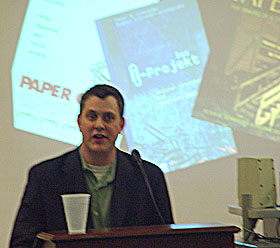"The collection of materials connects the past with the present."
 That was one of the thoughts expressed by Professor Daniel Magilow in his discussion Thursday afternoon on "Counting to Six Million: Collecting Projects and Holocaust Memorialization."
That was one of the thoughts expressed by Professor Daniel Magilow in his discussion Thursday afternoon on "Counting to Six Million: Collecting Projects and Holocaust Memorialization."
Magilow, who will spend the year as the Pearl Resnick Postdoctoral Fellow at the United States Holocaust Memorial Museum’s Center for Advanced Holocaust Study, told the story of the schoolchildren of Whitwell, Tennessee.
In 1998 a group of students began collecting paper clips as a way to understand the number 6,000,000 - the number of Jews killed in the Holocaust. Their efforts sparked approximately 125 other collections around the country.
Magilow’s research has taken him beyond the basic study of the events of the systematic extermination of the Jews by the Nazis during World War II, but of the process of collecting items or materials to represent those victims.
"There have been some strong critiques and objections to collections such as the Whitwell Project," said Magilow. "The criticisms have been historical, philosophical, and aesthetic."
One example is the historical inaccuracy of the collection rests in the wearing of paper clips by Norwegians during the German occupation.
"Norwegians wore paper clips to show they were proud to be Norwegian, not to show support for the Jews," Magilow said.
Another irony of the Whitwell collection was unplanned. The United States effort to smuggle German scientists out of the country during World War II was given the code name Project Paperclip.
Philosophical debates have included whether objects such as paper clips, buttons, or other items used to show a representation of the six million victims can truly provide an understanding of the events of that period.
Despite the arguments for or against the various collections and the efforts to serve as a memorial of the horrors of the Holocaust, Magilow spoke of the importance of the process.
"The criticisms overlook an important aspect. The Whitwell collection, and other Holocaust collections of buttons, eyeglasses or other items representing the victims emphasize the process of the memorialization over the memorials themselves."
For more information see: